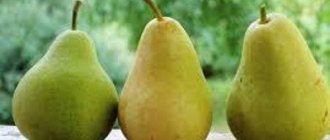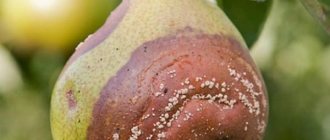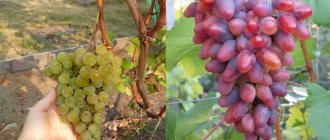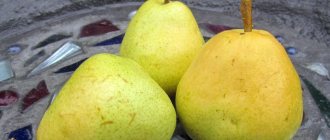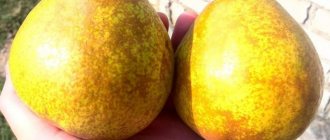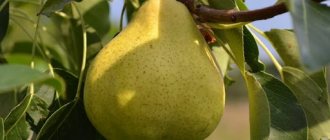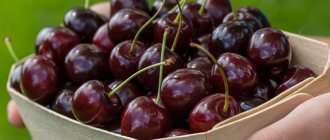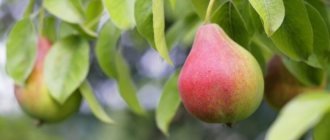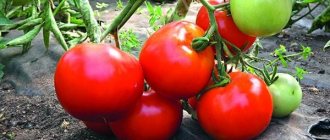Description of the pear variety Hera
The tree has a narrow pyramidal crown and grows up to 4 m in height. Fruits are formed on both annual shoots and perennial branches. They are straight, medium in thickness, brown in color, without hairiness.
The buds are medium in size and round in shape, tightly pressed to the branches. The leaf blades are dark green in color, with a shiny and smooth surface, medium in size and oval in shape.
Hera pear flowers are white in color with white petals. The process of budding and opening occurs at the end of spring. The flowers are up to 3 cm in diameter and almost completely cover the trunk.
Landing
Proper planting of the Hera variety will help lay the foundation for the long and full development of the fruit crop. You can read more in the articles at the link on how to fulfill all the landing requirements.
How to plant a pear tree correctly
At what distance to plant pears?
How to choose pear seedlings
How to replant a pear
Fruit characteristics
According to the description and photo, the Hera pear bears large fruits 4-5 years after planting, their weight ranges from 180 to 250 g. The skin is green, of medium density, and changes color to yellow as it ripens. A slight pinkish blush may be present. The core is round in shape and contains oblong brown seeds.
The pear pulp is fine-grained, cream-colored, and very juicy. Granulations (fossilized inclusions) may occur in fruits. According to the taste characteristics, Gera pears are sweet and sour, rated at 4.3 points. The fruits have an unobtrusive subtle aroma.
Important! The yield and taste of fruits are affected by soil quality, climate and lighting.
Violation of the rules of planting and care are factors contributing to the premature death of the plant.
Further care
If the tree has taken root well, the first fruits can be expected 4 years after planting. After 6 years, the tree begins to produce stable high yields.
Watering
A root groove is made for watering. The young tree is watered 2 times a month. During flowering and during the formation of the ovary, watering is increased.
Fertilizer
In the spring, nitrogen fertilizer is applied, before flowering and during fruit formation - magnesium sulfate. Once every 2-3 years, in mid-summer, phosphorus fertilizers are added to the soil.
Trimming
Gera’s crown does not need to be molded; sanitary pruning is enough for her. In spring, frozen branches are removed. When pruning in autumn, dry branches are removed.
Advantages and disadvantages of Hera pear
According to the description and reviews, the Gera pear variety is preferred to be cultivated in central Russia. The variety is known among gardeners due to the following qualities:
- high yield over a long period of time;
- frost resistance (up to - 38 ° C);
- high shelf life and the ability to transport over long distances;
- resistance to scab, septoria.
Important! Hera pear is a late-ripening variety; this feature should be taken into account when choosing a seedling.
No obvious deficiencies of the variety have been identified, but the fruits of the Gera pear lose their marketable appearance (darken) if the rules of transportation and indoor storage are violated.
How to grow crops correctly
Hera pear is an unpretentious variety created for growing in your personal garden plot. Hera is not used for industrial cultivation; the fruits lose their presentation during transportation.
Recommended timing
It is better to plant Hera in the fall, in September, although spring planting is also possible. Seedlings are characterized by excellent survival rate. If a pear is planted in the spring, this is done in May; when planting in the fall, the seedling should have time to adapt and take root in a new place before the onset of cold weather.
Site selection and soil preparation
For planting, choose sunny, dry, wind-protected areas. Pear does not tolerate waterlogged soil. It is not suitable for heavy soil, acidic or saline soil. Acidic soils are limed before planting. Do not plant pears in lowlands. Hera easily tolerates cold, so it can grow on a sunny hill without suffering from the wind.
The width and depth of the planting hole is 70-80 centimeters. It is prepared 7-10 days before planting. A drainage layer of broken bricks and gravel is laid at the bottom.
Selection and preparation of seedlings
1-2 year old seedlings are selected for planting. They must be strong, without visible damage to the trunk and roots. Options with dry twigs or roots are rejected. Before planting, the roots of the plant are treated with a preparation against fungi and bacteria and a growth stimulator.
Landing algorithm
The optimal mixture for pears is a 1:1 mixture of sand and humus with the addition of superphosphate and potassium sulfate. A mound of soil is placed at the bottom of the pit. A peg is dug in at a distance of 20-25 centimeters from the center of the hole. The seedling is placed on the top of an earthen mound and the roots are carefully straightened.
Fill the hole with the remaining soil mixture, compact the soil, eliminating voids. The seedling is tied to a peg. The planting is watered along the edge of the hole. The root collar should be above the surface of the planting hole.
See also
When and how to properly prune a pear and form a crown for beginnersRead
A day after planting, the seedling is pruned, leaving about 50 centimeters in height. This is done to form a lush crown. The tree trunk circle is mulched to retain moisture.
Optimal growing conditions
Pear grows wild in the countries of Europe and Central Asia, where it is a deciduous thicket. The fruits of this plant are small and have low taste.
In its cultivated form, Hera pear is grown in household plots located in the Urals, Western Siberia, Ukraine and Belarus, Japan and China. This wide distribution is facilitated not only by high yields, but also by ease of care and high frost resistance.
The optimal conditions for cultivating pears are fertile and loose soil with neutral or reduced acidity. On acidic or waterlogged soils, the seedling has difficulty taking root, produces a meager harvest or does not bear fruit.
Planting and caring for Hera pear
In autumn, it is preferable to transfer seedlings into the ground if the region has moderate climatic conditions without sudden changes in weather. If planting is successful, the first harvest is harvested after 4-5 years, and maximum fruiting is noted in the 10th year of growing the variety.
Landing rules
It is necessary to allocate a place on the site with sufficient lighting and absence of drafts. Before planting, dig a hole with a diameter of 80 cm and a depth of 1 m. If sandy soil predominates, peat is added to the humus in a ratio of 1:2.
The planting site is prepared a week before transferring the seedling to the site. Fertilizers with humus are added to the hole and filled with a bucket of water, add 3 tbsp. spoons of potassium sulfate. The next day, the humus is mixed and another 3 buckets of water are added. It is recommended to replant the variety a week after digging a hole.
Important! Hera pear seedlings do not take root well and grow slowly over 3 years. This is associated with poorly developed rhizomes.
A day before transferring the plant to the ground, it is left in a bucket of water to start biological processes in the seedling.
The Hera pear is placed in a hole and covered with soil. At the end of the procedure, the earth around is compacted and a hole is formed. The seedling is watered abundantly.
To prevent damage to the pear, it is recommended to construct a support from a wooden stake to which the trunk of the plant is tied.
Caring for the seedling consists of abundant watering for the first 30 days: 2 times a week. After the pear has rooted, the soil is moistened less frequently: before and after flowering and in the fall. The plant does not require insulation, so annual plantings are covered with snow. This procedure is not required in subsequent years.
Watering and fertilizing
Hera pear is drought-resistant, but to obtain the maximum amount of harvest, it is necessary to ensure soil moisture during the flowering period and after it. The irrigation rate for the seed is calculated: 3 buckets of water are poured per 1 m2 of soil. The procedure is carried out both by sprinkling and by irrigation furrows.
The procedure is carried out in the evening to avoid liquid getting on the leaf plates. For sprinkling, it is recommended to use special sprayers.
For surface watering in a circle around the trunk, the soil is loosened and grooves 10 to 15 cm deep are formed.
To prevent the soil from drying out, it is mulched with available materials (chopped straw, sawdust, leaves).
To maintain soil fertility, it is necessary to regularly apply fertilizers to it: in spring, summer and autumn. During the flowering period, the pear actively absorbs nitrogen, so fertilizers containing it are applied by scattering along the edge of the tree trunk.
In summer it is recommended to use complex supplements. In the fall, after fruiting has ended, preparations containing phosphorus and potassium are added to the soil.
Trimming
The procedure can be carried out regardless of the time of year. For crown formation, it is recommended to give preference to the autumn period. In spring, it is recommended to remove shoots that have frozen over the winter.
Important! If it is necessary to completely remove the shoot, pruning is carried out so that no stumps remain on the pear: at the base of the branch, near the trunk, there is a “ring”, which is the optimal place for cutting.
General recommendations for pruning Hera pear:
- heavily dense branches are thinned out to ensure full access to sunlight;
- trimming the trunk by ¼ helps prevent excessive growth of the variety;
- the cut site is treated with special preparations or garden varnish;
- Branches with signs of disease, dried out or growing at right angles must be removed.
If pruning needs to be done in the fall, then the optimal time is the beginning of October, when the foliage completely falls from the pear. When carrying out the procedure in the spring, wait until the end of February or the beginning of March.
Whitewash
To protect tree bark from sunlight, pests and temperature changes, whitewashing is carried out. It is recommended to perform the procedure twice: in spring and autumn. The preferred time for whitewashing is the end of fruiting (October-November).
If it is not possible to carry it out in the fall, it must be done in February to prevent cracks in the bark as a result of night frosts.
To prepare whitewash, dilute 3 kg of slaked lime, chalk or copper sulfate in 10 liters of water, then add 2-3 tablespoons of flour paste (you can replace 100 g of casein glue). The resulting mixture is thoroughly mixed and left to brew.
Important! For maximum protection, it is necessary to whitewash the lower third of the skeletal branches and the trunk. Mature trees cover a height of 18-2 m.
Before carrying out the procedure, you need to prepare the bark of the Hera pear: clean the trunks and branches of lichens and old bark. The use of metal knives and brushes is prohibited, as there is a high risk of damage to the plant.
Everything that was removed from the trunks and branches must be burned, and the peeled bark must be disinfected. To do this, in dry, windless weather, it is treated with a 5% solution of copper sulfate. If necessary, it is replaced with the drugs Abiga-Pik or Oksikhom. It is recommended to spray using a spray bottle.
Preparing for winter
At the end of fruiting, fallen pears and leaves are collected and burned, the soil is dug up and fertilizers are applied.
The Hera pear is frost-resistant, but for the purpose of prevention, the soil around the trunk is mulched using sawdust and humus.
To prevent rodents, the trunk is wrapped with mesh or any covering material. When preparing a seedling for winter, its branches are tied.
Landing Features
Pears, especially those with a pyramidal crown shape, are characterized by a weak root system. That is why, when planting a tree, it is very important to pay attention to the type of soil, the choice of seedlings, the timing and location of planting.
How to choose seedlings for planting
You need to purchase seedlings in the fall from a nursery or at a garden market. Two-year-old seedlings are used for planting. When purchasing, you must first carefully examine the roots: their tips should have a whitish tint, which indicates continued growth and recent removal from the soil.
The roots should be smooth, elastic, without blackening or growths. You should avoid purchasing seedlings with limp and dry foliage and buds.
Important! In order for the seedlings to take root better, they need to be left overnight in a bucket of water, and before planting, dipped in a mixture of 1 bucket of soil, 1 bucket of rotted manure and 300 g of phosphorus fertilizer.
When is the best time to plant
In temperate climates, pears can be planted in the fall (October), and in risky farming conditions (for example, in Siberia), Hera is better planted in the spring (late April-early May) to ensure root survival.
How to choose and prepare a place for planting
The pear tree does not like to be replanted, so the planting location is of paramount importance and must meet the following requirements:
- A distance of at least 3–4 m to fences and buildings.
- Availability of other varieties nearby for pollination.
- Good lighting, protection from the wind.
- Fertile soil (loam, chernozem, sandy soils are less suitable).
- Low groundwater level (at least 2 m) to prevent root rotting.
Before planting, sandy soil is additionally fertilized with 1 bucket of rotted manure mixed with 2 buckets of peat. In clay soil, drainage is done (a layer of stones is laid at the bottom of the hole).
The planting pit is prepared 2 weeks before planting. Minimum dimensions of the planting pit: 1 m deep and 80 cm in diameter.
Having dug a hole, pour into it:
- 3–5 buckets of humus;
- 200 g of complex fertilizer (for example, “Azofoski”);
- 2 buckets of sand;
- 2 buckets of water;
- dolomite flour solution (600 g flour per 10 liters of water);
- excavated soil.
In a couple of weeks, the minerals will dissolve and the roots of the seedlings will not get burned. In addition, during this time the soil will shrink, which will also promote root survival.
Immediately before planting, the hole must be watered with a root growth stimulator. When planting in spring, the hole can be dug in the fall to kill pests and bacteria.
Planting scheme
Hera and other medium-sized varieties are planted at a distance of 4 m between seedlings and 5–6 m between rows (in large farms and gardens).
Productivity
The Hera pear is characterized by high yield: up to 40 kg per tree. For harvesting, cloth gloves are used, separating the fruit from the tree along with the stalk.
For maximum safety of the pear, you must adhere to the following rules:
- the fruit is placed in a ventilated, dark place where the humidity is 85% and the temperature is up to + 1 ° C;
- put Hera pears in a wooden box with sawdust, where each fruit is wrapped in paper;
- overripe or spoiled fruits cannot be stored;
- Pears need to be sorted periodically; fruits with defects are disposed of.
Fruits can be frozen; cut fruits can be stored in the refrigerator for 24 hours.
Diseases and pests
Hera pear is resistant to diseases such as scab and septoria, but there are pests and diseases that can lead to the death of the plant.
Black cancer affects leaf blades, shoots and fruits. To get rid of it, the damaged bark must be removed and the trunk treated with garden varnish. Whole shoots are sprayed with copper sulfate.
Moniliosis is characterized by rotting of the fruits on the branch. Affected fruits that have fallen to the ground are collected and disposed of, and the tree is treated prophylactically with a phytosporin solution.
Powdery mildew is characterized by the appearance of a white coating on the leaf blades. As the disease progresses, they curl up and fall off. For treatment and prevention, the pear is treated with a solution of Fundazol.
Dangerous parasites for pears that can harm the variety:
- codling moth;
- green aphids;
- pear mite;
- psyllid
To combat pests, it is necessary to promptly remove and burn all foliage. Digging of the soil, whitewashing and regular inspection of the pear are mandatory.
Reviews from gardeners about Hera pear
Samoilov Andrey Igorevich, 41 years old, Astrakhan
Hera pear is an excellent high-yielding winter pear variety. The tree has a neat crown and easily tolerates frost. The fruits are dense, but sweet, with a slight graininess. I store the harvest all winter in the basement: the taste and appearance do not change.
Kutuzova Lyudmila Ivanovna, 57 years old, Chelyabinsk.
In my garden, Hera pear is a favorite variety. The fruits are large, sweet and have a long shelf life. The tree requires care: feeding and pruning. Be sure to whiten the trunks and dig up the soil in the fall and spring. During 7 years of cultivation there was not a single year of poor harvest.
